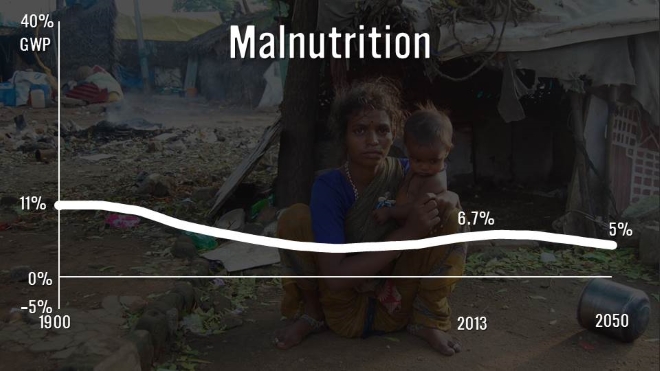A Scorecard for Humanity: Malnutrition, Horton Steckel
Assessment Paper
By Sue Horton and Richard H. Steckel
A version of the working paper is available for download here. The finalized paper has been published in How Much Have Global Problems Cost the World? A Scorecard from 1900 - 2050 by Cambridge University Press.

Hunger, one of humanity’s oldest scourges, has relented. The researchers measured it through height, a strong indicator of childhood starvation. In 1900, the average rich world male adult was just 169cm, and 164cm in the poor world -- now 177cm and 168cm. While a 4cm increase in the developing world may not sound like much, it indicates going from 10% moderate starvation to virtually nil, meaning 1.5 million fewer kids die each year from malnutrition.
The cost of malnutrition has almost halved from 11% of GDP in 1900 to 6% today, and should fall to 5% in 2050 -- magnificent progress but it also shows there is still much to do.
Short summary
The two-way link between improved nutrition and higher income is well known. Higher income allows people to obtain a more varied and nutritious diet. Higher income is associated with improved sanitation and health, such that there is less loss of nutrients associated with infection. More maternal education (associated with higher income) is associated with better infant feeding practices, and mothers who are better able to obtain care for themselves during pregnancy. Of course, higher income also can bring with it an overly sedentary lifestyle, excess consumption of fat and added sugar, and associated risks of non-communicable disease. However in this chapter we focus on the beneficial aspects of income for nutrition because a large share of the world’s population was stunted during much or most of the 20th century.
Similarly, better nutrition is associated with higher productivity. Better nourished individuals are more productive in physical labour, because of higher stamina, higher maximal work output etc. Better nourished infants and young children have improved cognitive skills, which translate to higher productivity as adults. We use the results from micro-level data to disentangle the effect of nutrition on productivity from that of income on nutrition, making broad estimates over the past century for various world regions.
During the 20th century, nutrition improved considerably in most regions of the world, as evidenced by increases in stature. This increase in stature was not uniform (some countries did not experience an improvement), and the timing and rate of this increase varied greatly. Data suggest that as living standards improve (associated with modern economic growth), mean height of young adults/all adults/conscripts (a sample for whom data are readily available) in national populations can increase from 163cm or even lower, up towards 178 cm. Mean heights lower than 160cm have been observed in subpopulations of particular ethnic groups (pygmies, Bushmen for example in Africa; Maya, Quechua and Yanomano in Latin America), as well as in regions of particularly low per capita income (for example, Japanese conscripts recruited in 1900). However, the assumption is that all populations have similar genetic potential for height, even though this may take more than one generation to achieve. Data on heights of wealthy households in different countries support this assumption.
Height is a good indicator of long-run nutritional status. In this regard it is useful to think of the human body as a biological machine that receives fuel as a mixture of protein, calories, micronutrients, and so forth, which it expends on basal metabolism (maintaining vital functions while at rest), physical activity and fighting infections. Physical growth ceases if net nutrition is poor but children experience catch-up growth if conditions improve. Anthropometric studies around the globe show that individuals who are malnourished as young children are stunted as adults, and the extent of stunting depends upon the duration, timing and severity of malnutrition. Stunting is commonly measured by height-for-age (by sex) relative to international standards. Evidence on children adopted from poor into rich countries shows that the human capacity for catch up or compensatory growth may be substantial (but still incomplete) depending upon the quality of nutrition and the age at which conditions improve.
Height does not capture all the beneficial effects of nutrition. For undernourished adults, improved diet (both in calories and micronutrients) can improve productivity. For children, improved micronutrient status can have effects on cognitive development independent of height. However we do not have worldwide data on calorie availability and distribution over the past century, nor on micronutrient status of children. Hence our estimates underestimate the benefits of improved nutrition.
The estimates suggest that undernutrition has been a cause of a significant, slowly-declining, loss of global productivity. We estimate that this loss was 8% of world GDP over the twentieth century, and will decline to 6% of world GDP in the first half of the twentieth century. The losses are largely associated with impaired cognition which directly reduces productivity, with reduced educational attainment, as well as lower productivity of undernourished adults in manual work.
The projections from 2010 to 2050 show much stronger impacts of improved nutrition on productivity. Although using height to measure nutrition underestimates both the productivity losses and the mortality losses, unfortunately there is no other measure that can be used for the whole century, nor for a global study. Despite the limitations of the measure, the differences between regions and by decades are very informative.
The paper does not touch on what could have been done to improve nutrition – and hence reduce child mortality, and increase world GDP – during the twentieth century. The cost-effectiveness of nutrition interventions is another big topic in itself

